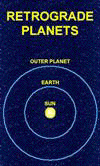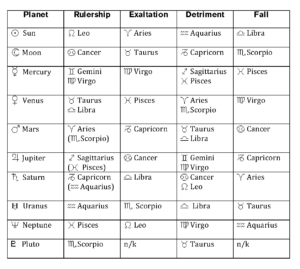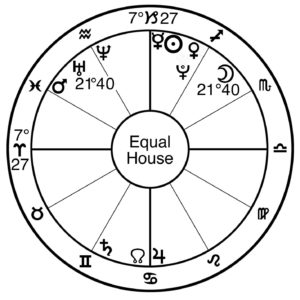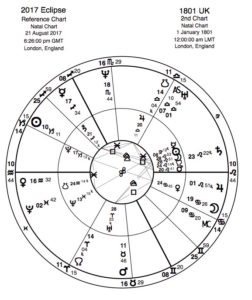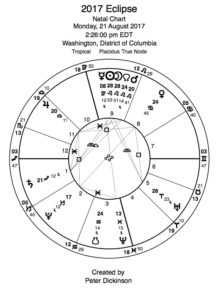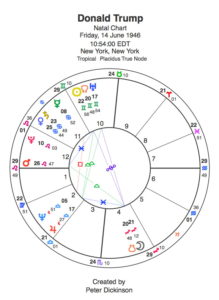If you read practically any astrological forecast worthy of the name you will, on occasion, come across a reference to a planet ‘turning Retrograde’ or ‘turning Direct.’ This is not infrequent, quite normal and does not mean that the sky is about to fall in. Neither does it mean that whichever planet is under discussion has changed course and is now orbiting the Sun in reverse. It’s just that, from our point of view on Earth, said planet just looks as if it’s going backwards.
The Astronomy
With the exception of the Sun and the Moon, all the planets of the Solar system occasionally perform this optical illusion. Why? Because although all the Sun’s family orbit in the same direction, at certain times during the orbit of each planet it appears to be going in the opposite direction, seen from our point of view against the background stars.
For example, Pluto is currently in Capricorn and will be for some time. On April 22nd it turned Retrograde. It will stay that way, apparently moving backwards, until September 1st. It actually does the same thing every year, like all the other planets. This process is because both the Earth and Pluto are, at that time, on the same side of the Sun, both moving in the same direction and the Earth is overtaking Pluto.
Think of them as two cars on a circular track. The Earth is in the inside lane, Pluto in the outside lane. Pluto is dawdling around the outside, Earth is hurtling (relatively speaking) round the inside. Imagine twelve advertisement hoardings (constellations) around the track. Currently (that is, meaning until late 2024) Pluto is moving past the one for the Capricorn Law School and the Earth is passing the one for the Leo Magnificent Hair Stylists and heading for the Virgo Academy For Ladies Of Good Reputation. From that point, and until the Earth gets to the Libra Social Club in September, Pluto will appear, to someone in the inside car, to be moving backwards against the Capricorn advert, even though it’s still moving forwards. Relative motion, you see.
You can see how it works if you go to https://www.theplanetstoday.com/solar_system_video_2018 and be fascinated by the dance of the Solar system.
Inside track
That state of affairs obtains for all the planets outside Earth’s orbit; Mars, Jupiter, Saturn, Uranus, Neptune and Pluto. For Venus and Mercury it’s a little bit different.
As with the outer planets, we have to be on the same side of the Sun for the retrograde motion to be observed. With Venus and Mercury, though, they are the ones that are doing the overtaking.
It works the same way for both but we’ll take Mercury as the example as it happens most often with this planet. Mercury orbits the Sun four times as fast as we do so it’s positively racing round. When it’s on the other side of the Sun from us it’s going forwards, from our point of view. When it reaches a point 28 degrees ahead of the Sun in the Zodiac, however, it apparently reverses direction and starts going backwards. It’s reached the point in its orbit where it’s racing up on our inside, as it were. To us it looks as if it’s going the ‘wrong’ way and it continues to do so until it’s the same distance behind the Sun. Then it apparently starts to go forwards again and normality is resumed.
None of this is terribly easy to visualise (and you try explaining it in words!) so perhaps the illustration will give you a better idea. That’s assuming it works…
Retrograde periods
As far as frequency is concerned, Pluto, Neptune, Uranus and Saturn are retrograde for a time each year; Pluto currently for about six months (as noted above, April to September this year); Neptune the same (June 18th to November 24th); Uranus again about five months (August 7th to January 5th 2019); Saturn is about four months (April 18th to September 5th this year); Jupiter is another four-month job (started March 9th and finished July 9th); Mars turns Retrograde about every 26 months which lasts for 10-12 weeks and is currently on; it turned Retrograde on June 26th and will remain that way until it turns Direct on August 26th; Venus retrograde periods happen every 19 months or so, last for five to seven weeks and the next one starts on October 5th; Mercury goes retrograde at intervals of three to four months for about three weeks at a time and does just that on July 26th until August 19th. The one after that starts in mid-November.
The Astrology
All that astronomy (or should it be geometry?) is all very well, I hear you say, but what does it all mean? I can only make sweeping generalisations here as specific effects on individuals will depend on personal charts. To some extent even the generalisations depend upon the sign in which a retrograde planet finds itself. But let’s have a look at those general effects, planet by planet.
Mercury
This is the one that’s best known, mainly due to its frequency and because it has the widest general effects. Mercury rules transport and communication which boils down, basically, to anything that moves goods, people or information from one place to another. During a retrograde phase letters and parcels go slow or go missing, journeys are delayed for one reason or another (things like leaves on the line or fog closing the airport at the other end of your flight), phone calls go astray or the other party isn’t there, emails do strange things (they do strange things at the best of times but under retrograde Mercury they can be positively weird!) and things like that. It even has the effect sometimes that people don’t think quite so well as normal, especially if Mercury is in Pisces, and Mercury retrograde in Capricorn can get positively ossified!
What to do? Try to be patient, allow extra time for journeys, take extra care generally. Use the time to catch up with filing, correspondence and paperwork of all sorts, go over plans (but don’t put them in motion) and hang in there until Mercury turns direct.
One other small thing, while we’re on Mercury. Sometimes the worst effects of a Mercury Retrograde period actually happen in the week before the retrogradation takes place. No, I haven’t a clue why that is, either, but I’m thinking about it hard…
Venus
This planet rules pleasures in general, art and society in particular along with national celebrations and the like. During a retrograde phase there’s a tinge of nostalgia about things and this is where the catwalks and galleries may be full of backward-looking designs and pictures. There are also economic effects; sometimes there’s an air of retrenchment (but not recession) especially among small investors and basically a bit of caution about. It’s not, though, a time of gloom and despondency as one might think.
With Venus backing up it’s a time to review one’s progress in personal relationships (of all kinds) and with personal finances. It’s a strange combination, on the surface, but these two are ruled by Venus and they do go hand in hand on some levels. See where you are and where you want to go from here. Deal with any old situations that turn up. Try not to start new love affairs; nobody knows when Cupid’s arrow is going to strike but romances started under a retrograde Venus may well just fizzle out.
Mars
Mars is the pushy planet—it’s all about action and adrenalin. It rules fighting, cutting edges and pointy things and therefore the armed forces, surgery and anything to do with cutting or penetrating instruments and implements. In a retrograde period there are likely to be reviews of Defence spending, hospital waiting lists and sales targets. It’s a time when the world draws breath and takes a bit of time out to see where it is and to take aim at the next goal.
On a personal level direct action is difficult and is likely to be frustrated. Again, it’s a time for review, in this case of one’s personal goals and the progress one has made towards them. Decide whether it’s worth carrying on or whether one should cut one’s losses and find a new direction. Finish anything left incomplete and do repairs and tidying up.
Jupiter
This planet’s bailiwick is organised religion and the clergy (also philosophy and theology, non-organised variety), the law and judges, big business such as banking and insurance and higher education. As there’s a more regular annual retrograde period for all the planets from Jupiter outwards there’s a sort of tidal effect as things push forward for a time and then draw back a little before pushing on further again. Also, as we work outwards through the Solar system the planetary effects become longer-term and less personal and therefore not quite so immediately noticeable.
Inside there’s some sort of inner review going on of personal ideals and belief systems—not a wholesale overturning of the present situation (although that can happen) but more of a deep pondering of one or two particular questions. On the outside it’s perhaps a good idea to have a chat with a financial adviser to review your overall finances and see where long-term improvements and investments can be made.
Saturn
Property, Government and heads of state come under Saturn. It’s the workings, as well as the voice, of Authority. This planet holds sway over structure and organisation, whether it’s a set of rules or the hierarchy of the local Council. Retrograde periods see reviews in the rules and changes are made where—and only if—necessary.
An inner check of attitudes to responsibility and duty is a good idea. Also look at the way one deals with obstacles to progress, whether inner development or everyday challenges.
Uranus
Uranus rules physical power (electricity, for example) as well as administrative bodies such as Parliament (UK), Congress (USA) and similar talking shops. These have their own challenges to meet when Uranus is retrograde and, given the Uranian tendency towards the sudden and unexpected, those challenges usually arrive out of a clear blue sky and shake everything up. Just Uranus doing his job.
If you know Uranus retrograde is coming, be prepared for just about anything to come along and shake one’s complacency. If it’s working on your personal chart it’s something along the lines of ‘Is this the way I want to go…’ and can have the appearance to others of a sudden switch in direction. Under the general effects of the retrograde period, though, outside factors may just cause little shifts here and there which are fairly easy to assimilate.
Neptune
Hospitals, charities, the Navy, alcohol, chemicals, drugs, mysticism. What a mixture! Neptune enfolds all these things and does not generally accept boundaries but during a retrograde period these, too, come under review and are set (or re-set) to suit the present time and situation.
The same thing goes on a personal level. Again, unless there is an aspect to one’s personal chart it’s unlikely (especially with good ol’ smoke-and-mirrors Neptune) that any change will be apparent until one day one notices some change that crept in somewhere and settled down to wait until it was noticed!
Pluto
Mines, underground installations, the criminal underworld (and therefore also police and detectives) and public safety are Plutonian subjects. Again, these things are checked over during the planet’s retrograde period but as Pluto deals with things ‘under the surface’ we don’t necessarily know what’s been going on until the news sees the light of day.
On a personal level Pluto represents deep inner transformations. These don’t happen very often and, like those of Neptune, they may take a while to make their presence felt. During the retrograde period, though, keep in mind that the only constant is change and do an inner review of just how you are doing with changing things, whether internal attitudes or external circumstances.
Conclusion
Generally speaking, the retrograde period of any planet is a time to go back over whatever that planet represents, assimilate any lessons, gather any harvests or rewards and then move on to the next stage. It’s what keeps us learning, changing and growing as we go through life and it certainly stops us from being bored!

